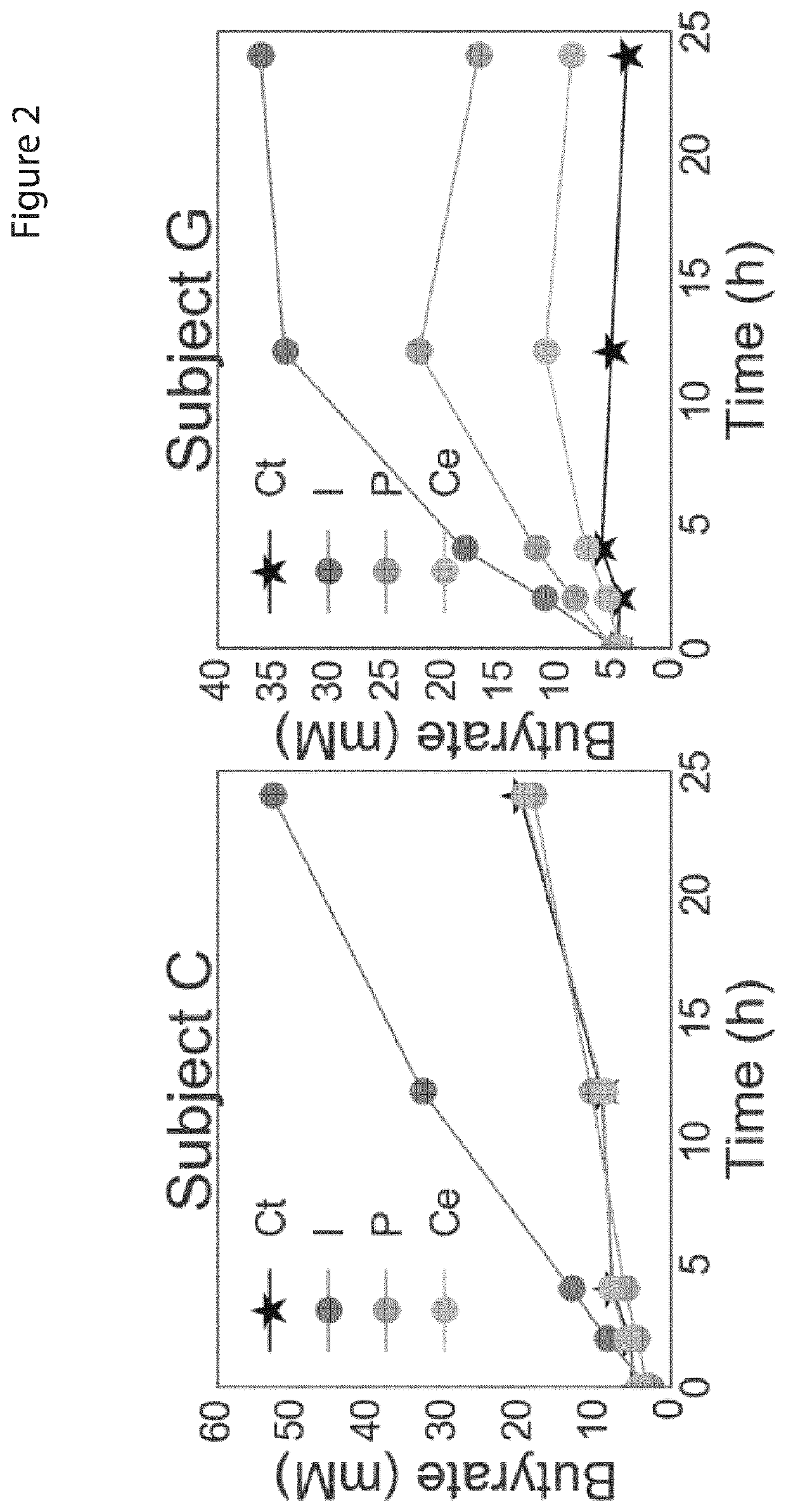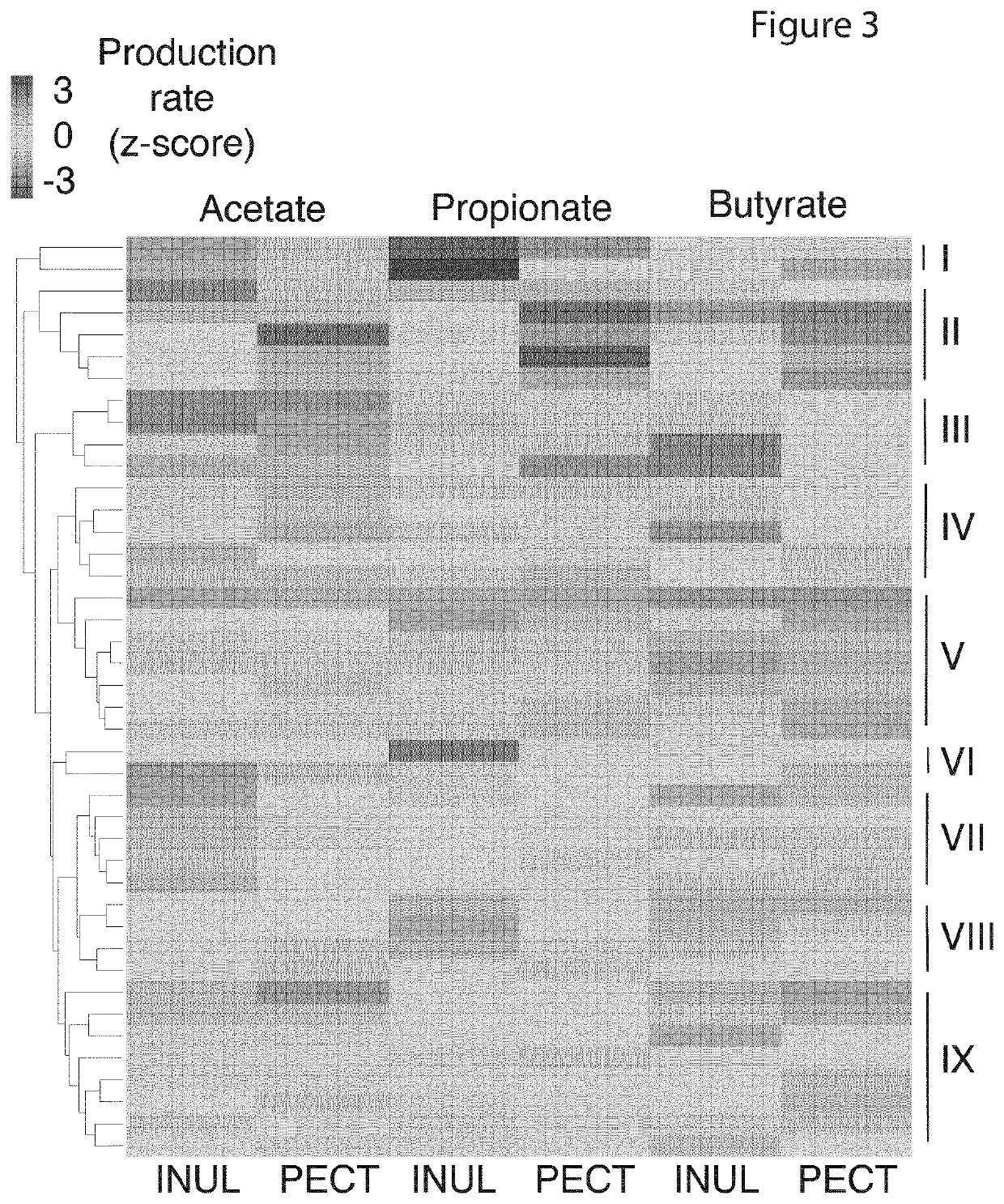Predicting The Response Of A Microbiota To Dietary Fibers
a microbiota and dietary fiber technology, applied in the field of human gut microbiota and its metabolic capabilities, can solve the problems of relatively little known about functional differences, achieve the effects of maximizing the production of a given scfa, maximizing the production of butyrate, and laborious, costly and logistically high limi
- Summary
- Abstract
- Description
- Claims
- Application Information
AI Technical Summary
Benefits of technology
Problems solved by technology
Method used
Image
Examples
example 1
[0212]Ex Vivo Measurements of SCFA Production
[0213]To measure SCFA production ex vivo in response to different dietary polysaccharides, stool from 40 healthy human participants was homogenized into a slurry in anaerobic conditions and spiked with inulin, pectin or cellulose (cf. Methods). The slurry was then allowed to evolve over time and samples obtained at regular intervals in order to quantify SCFA content at each timepoint (FIG. 1). In order to determine the appropriate sampling frequency, Applicants performed pilot experiments in which Applicants analysed the trajectory of each SCFA concentration over a 24 h period. Applicants found that only a subset of participants appeared to converge to a final SCFA concentration prior to the 24 h timepoint, but that all participants exhibited a linear production rate in the 0-4 h time window (FIG. 2). These data were in good agreement with concentrations of inulin measured from the stool over time using an inulin-specific ELISA assay: aft...
example 2
[0215]Predicting Microbial Metabolic Phenotype from Community Composition
[0216]Applicants then asked the question whether Applicants could predict a participant's MMP from community composition alone, defined here as the relative abundances of 97% de novo OTUs obtained from 16S rRNA sequencing of the stool prior to incubation with the different fibers. Applicants trained Random Forest Classifiers (RFCs) to predict whether a given microbiota had a high or low production rate of a given SCFA in response to a given fiber, defined by a production rate z-score of greater than or equal to 0, or less than 0, respectively. Performance varied by SCFA, with the highest accuracies obtained in predicting butyrate production in response to inulin (AUC=0.87) and pectin (AUC=0.79) (FIG. 4).
[0217]Applicants also tested whether straight stool SCFA contents could be predicted from 16S rRNA sequencing and found moderate predictive power for acetate and butyrate (AUC=0.76 and AUC=0.73, respectively). T...
example 3
[0218]Stability of an Individual's MMP Through Time
[0219]While it is known that the gut microbiota of individuals can be relatively stable for long periods of time in the absence of large perturbations, it is unclear whether an individual's MMP will also be similarly stable through time. Applicants therefore repeated the experiment for eight participants at timepoints separated by at least 6 months (FIG. 6a). Though some variability between timepoints was observed, the extrema of each individual's MMP were generally preserved (FIG. 6b). A Fisher test on the contingency table resulting from pairwise comparison of each SCFA:fiber pair at the two timepoints for all individuals indicated that this stability was statistically significant (p=0.003; two-tailed Fisher test). These results were consistent with the fact that MMPs are associated with the relative abundance of specific members of the microbiota: an individual with a high relative abundance of the aforementioned P. copri OTU is ...
PUM
 Login to View More
Login to View More Abstract
Description
Claims
Application Information
 Login to View More
Login to View More - R&D
- Intellectual Property
- Life Sciences
- Materials
- Tech Scout
- Unparalleled Data Quality
- Higher Quality Content
- 60% Fewer Hallucinations
Browse by: Latest US Patents, China's latest patents, Technical Efficacy Thesaurus, Application Domain, Technology Topic, Popular Technical Reports.
© 2025 PatSnap. All rights reserved.Legal|Privacy policy|Modern Slavery Act Transparency Statement|Sitemap|About US| Contact US: help@patsnap.com



